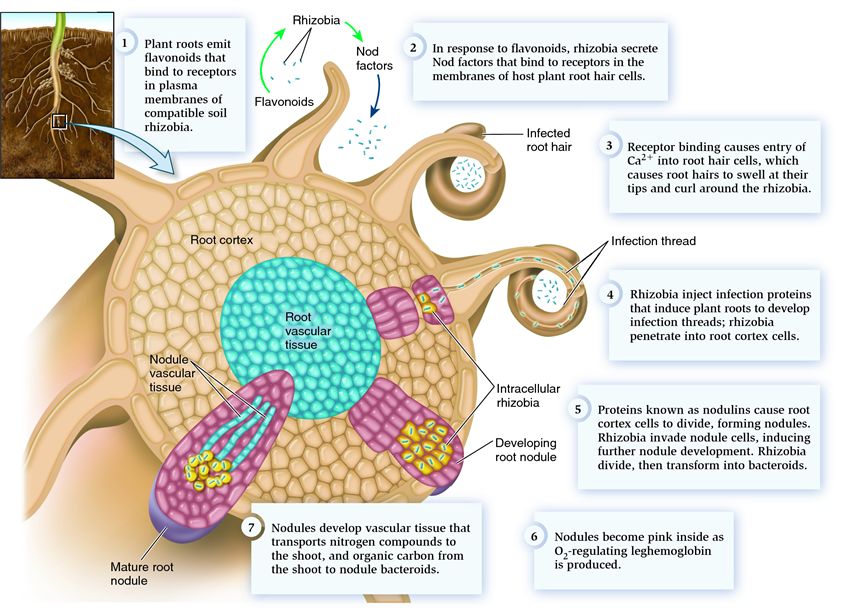 |
| Previous Image | Next Image |
| Description: Nodule development involves a series of chemical signals sent back and forth between rhizobia and their host plants. Legumes start this exchange by secreting particular flavonoid compounds from their roots. Recall that flavonoids are phenolic secondary metabolites that play essential roles in plant structure, reproduction, and protection. These flavonoids bind to receptors in the plasma membranes of compatible soil rhizobia (step 1). In response, the rhizobia secrete Nod factors (nodulation factors). Each rhizobial species produces Nod factors with distinctive structural variations that can be recognized by the preferred host species. These Nod factors function something like keys that unlock doors, allowing bacteria to enter roots via root hairs. These factors bind to receptors in the membranes of root hair cells in the host plant (step 2). Within minutes after its membrane receptors bind the Nod factors, the root hair plasma membrane allows an influx of calcium ions, and a few minutes later root hair calcium concentrations start oscillating rapidly. Root hairs respond to these calcium changes by swelling at their tips and curling around the rhizobia (step 3). The rhizobia then inject infection proteins into root hairs. In response, the root hair cell wall degrades and the plasma membrane forms a tubular thread that the rhizobia enter. Rhizobia move through this infection thread into the root cortex and the tip of the infection thread fuses with the plasma membrane of a cortex cell. The rhizobia are then released into the cortex cell cytoplasm, enclosed by the host membrane (step 4). Meanwhile, plants produce proteins known as nodulins that foster nodule development. Within 18–30 hours after the initial infection, root cortex cells start to divide to form root nodules. Environmental conditions in developing nodules cause rhizobia to undergo changes in their structure and gene expression patterns. The modified rhizobia present in mature nodules are known as bacteroids (step 5). Legume nodules typically produce leghemoglobin (legume hemoglobin), a pink protein that helps regulate local oxygen concentrations (step 6). By so doing, leghemoglobin prevents oxygen from poisoning nitrogenase while still allowing bacteroids to accomplish aerobic respiration. Bacteroid respiration provides the large amounts of ATP that are necessary for nitrogen fixation. Mature nodules also produce vascular tissue that moves nitrogen fixed by bacteroids to the root vascular system for transport throughout the plant. These nodule vascular tissues also supply organic food produced by the legume to their bacteroid partners (step 7). In 2004, plant molecular biologists Melanie Barnett, Sharon Long, and their colleagues produced a type of a DNA microarray called a symbiosis chip that contains the genomes of both a legume plant host, Medicago truncatula, and its rhizobial symbiont, Sinorhizobium meliloti. This chip allows investigators to study gene expression in both partners simultaneously, revealing that nearly 5,000 gene expression changes are associated with the legume-rhizobia symbiosis. Picture Stats: Views: 11626 Filesize: 109.09kB Height: 614 Width: 850 Source: https://biology-forums.com/index.php?action=gallery;sa=view;id=1011 |
